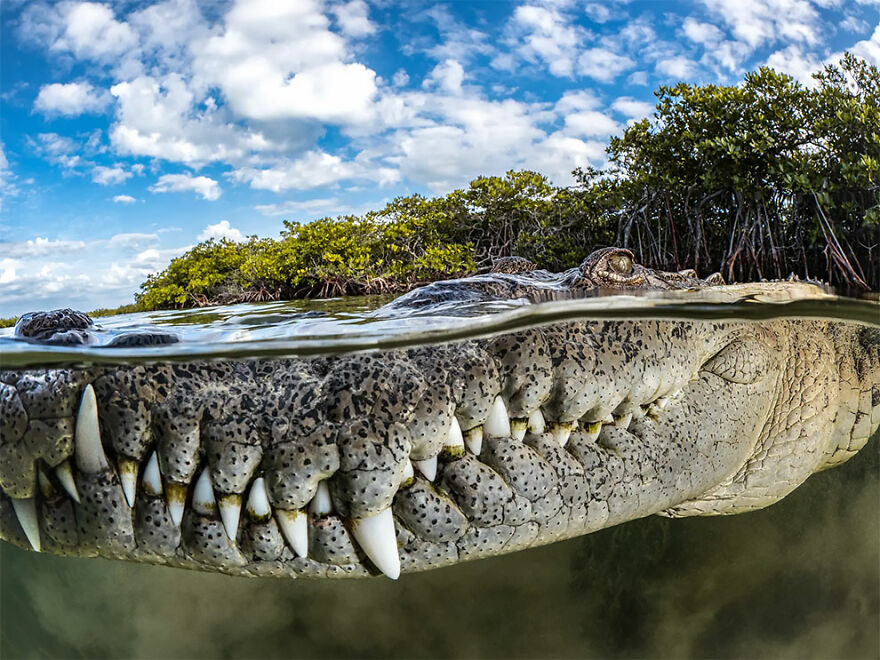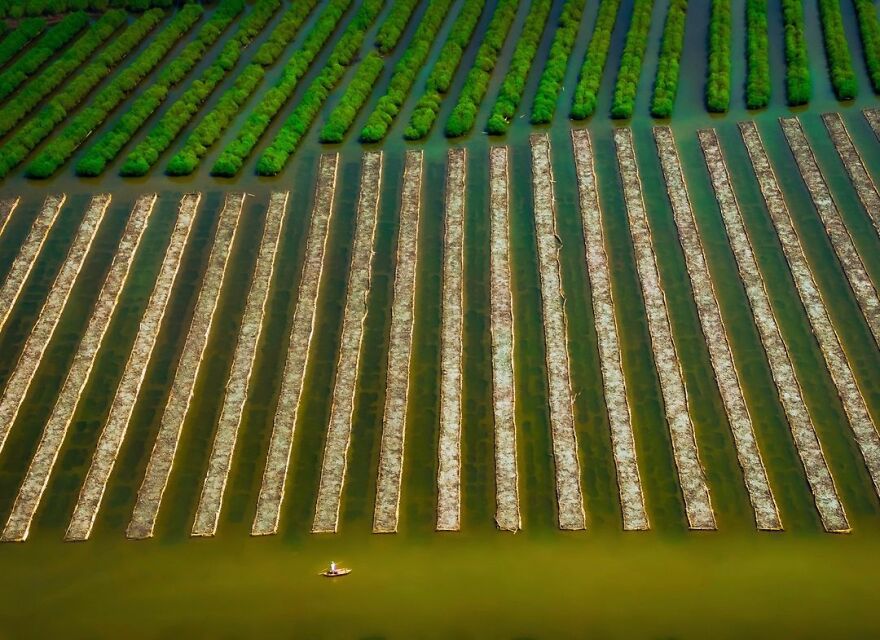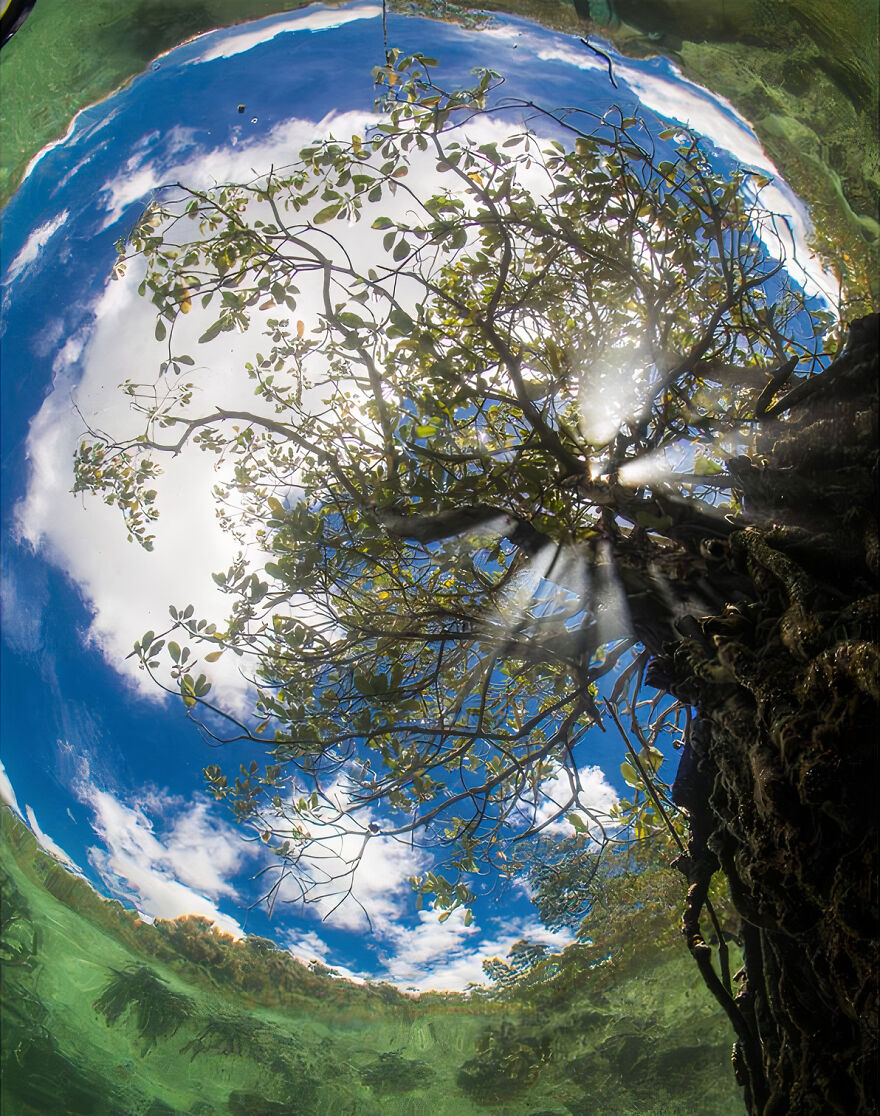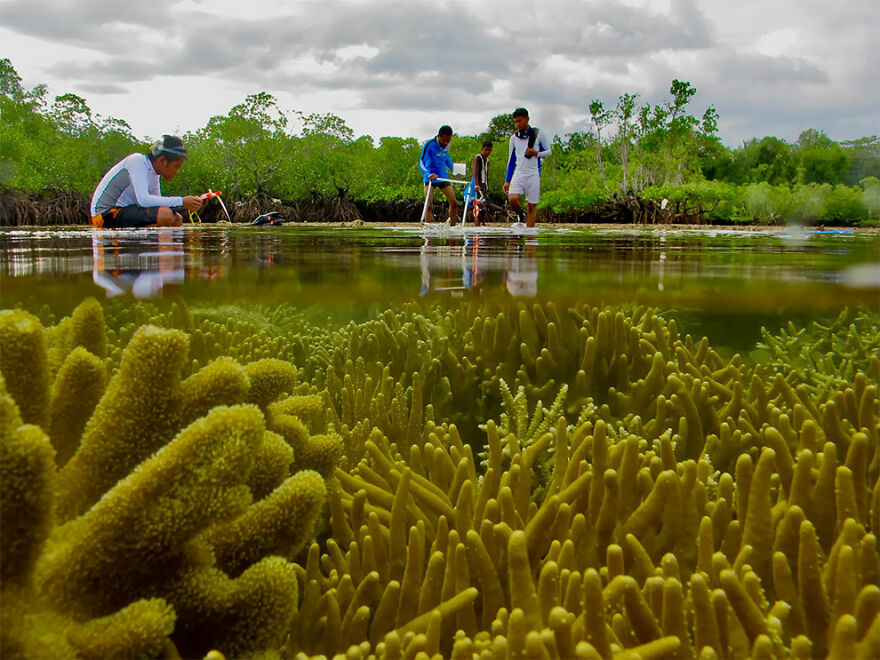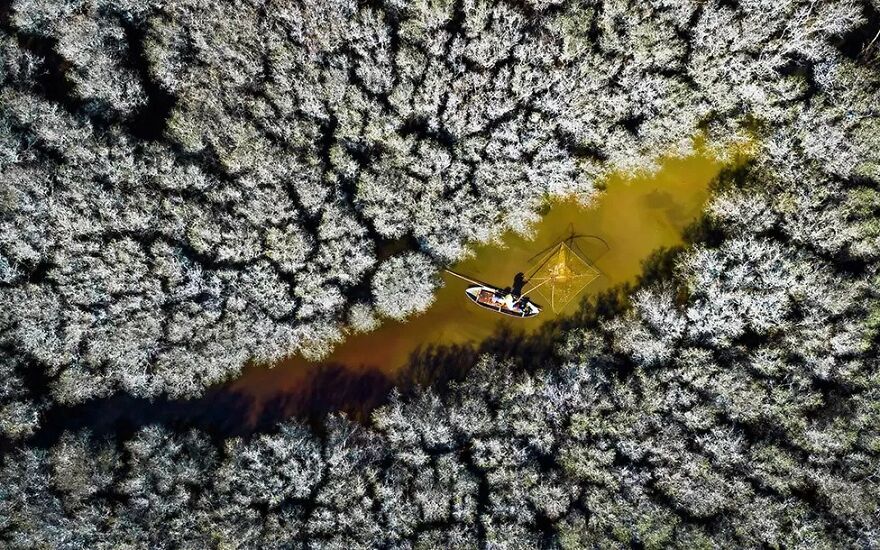
19Kviews
Mangroves And Ecosystems: 30 Best Pictures Of 2022 Mangrove Photography Awards
InterviewBehind every photo, there is a story. So in these images below, let us tell you a story about mangroves and their importance to our ecosystems.
During the annual Mangrove Photography Awards, photographers all over the world are encouraged to participate by showcasing and uncovering the secret worlds of mangroves.
It is a great opportunity to put mangroves in the spotlight and have a way to observe the value that they provide to our ecosystems. As written on the Nasa earth observatory page: "Mangrove forests are typically made up of trees, shrubs, and palms that have adapted to the harsh conditions and they are fertile nurseries for many marine species, and also serve as the first line of defense against hurricanes and tsunamis by dissipating wave and wind energy."
The aim of the Mangrove Action Project is to illustrate the importance and diversity of life in our coastal forests and engage audiences in mangrove issues and stories whilst inspiring people to take conservation action.
More info: photography.mangroveactionproject.org | Instagram | Facebook | Instagram
This post may include affiliate links.
Winner Of Mangroves And Landscape: Walakiri Dancing Trees - Loïc Dupuis, Indonesia
The sun rises along the peaceful beaches of East Sumba in Indonesia. “I wanted to capture the beauty and fragility of this unique wonder. We need to protect and visit places like this with great care, so future generations can also enjoy them.”
Bored Panda got in touch with one of the contest organizers, Leo, to get to know more about the contest's past.
Leo shared: “I set up the photo contest back in 2015 to try and raise the profile of mangrove forests by showcasing their beauty. Mangroves are so undervalued, often get a bad reputation for smelling bad (a result of organic matter breaking down), being mosquito-filled, and are still seen as ‘wastelands’ in many places. A lot of people don’t know what a mangrove forest is, including me before I started working with them, and I wanted to show everyone how incredibly important they are for us and the planet.”
He added: “We also run the contest in celebration of World Mangrove Day which is on the 26th of July.”
Winner Of Mangroves And Underwater: Blue Crab - Martin Broen, Mexico
The mysteries of a rarely seen natural environment. A blue crab (Callinectes sapidus) fishing in a unique transition between fresh and saltwater in the Mexican cenotes. "During an exploration dive through the dark flooded caves, I came across this proudly standing crab silhouetted against the mangrove roots above."
Tree Of Life - Amar Habeeb, Uae
Most of the mangroves found along UAE’s coastline are found in Abu Dhabi, acting as a “green lung” for the city. Patterns resembling a tree-like structure were spotted in the mangroves.
We saw a lot of amazing and eye-opening photos in the contest and were wondering if anyone is welcome to participate. Leo wrote: “Absolutely anyone can participate in this contest. We invite everyone of all levels of photography, of all ages and disciplines to submit their best mangrove images.”
“There are 6 categories in which participants can submit their images - Wildlife, Human, Landscape, Underwater, Conservation, and Stories (a portfolio category). Any young photographers submitting images compete to be crowned Young Mangrove Photographer of the Year.”
Flying Crocodile - Alvaro Herrero Lopez-Bletran, Mexico
A view from below. A crocodile swims in the open water area of a cenote, surrounded by mangroves.
Photo Of The Year: Guardian Of The Mangroves - Tanya Houppermans, Cuba
‘‘Guardian of the Mangroves’ captures an intimate moment when a curious American crocodile (Crocodylus acutus) swam right up to Tanya Houppermans, and allowed her into its world of luscious mangroves at Gardens of the Queen (Jardines De La Reina).”
Gardens of the Queen is an archipelago off the coast of Cuba, that has been strictly protected since 1996, and is one of the most untouched marine ecosystems in the world.
“The healthy population of American crocodiles is down to the pristine condition of the mangroves and I wanted to capture close-ups of this gentle giant in its natural habitat. I hope this image can illustrate that protecting areas like this is so critical.”
He also shared more about the selection process: “It's always so tough to select the winners as we go through all the wonderful submissions, each with a unique story behind it. There are rounds of judging by a panel of professional wildlife and conservation photographers who look for image originality, technical excellence, composition, overall impact, and artistic merit. This year’s judges included Dhritiman Mukherjee, Beverly Joubert, Octavio Aburto, Nadia Aly, and Bertie Gregory.”Being a winner of this contest is not only great for the fame, and spreading awareness, but also for the prizes.
Leo shared: “There is a cash prize for the overall winner and winners of the 6 categories. We also have some great products donated by some of our sponsors which will be sent out.”
Winner Of Mangroves And Humans: Honey Hunters - Muhammad Mostafigur Rahman, Bangladesh
'Honey Hunters' collect wild honey deep in the mangroves of the Sundarbans, the largest mangrove forest in the world. This ancient traditional event takes place every year during March and April, following the raw rhythms of nature.
This extraordinary relationship between the Moulis ‘honey hunters’ and the mangrove forest is unique and in danger of disappearing. Both recent human development in the area and the climate crisis, in particular the rise in sea levels, are threatening the ecology of the Sundarbans and with it, the way of life of the Moulis people.
Winner Of Mangroves And Landscapes: Dreamlife Of Mangroves - Melodi Roberts, USA
Reflections at dawn on the Merritt Island National Wildlife Refuge, Florida. "The refuge became a place for me to satisfy a need for quiet and peace where language and reason fall away, and the mind settles into a stillness and opens to a connection with all things."
Lastly, we were wondering how the organizers feel about this year's contest and whether it was a success.
Leo wrote: “It's been such a joy looking through all the submissions and not just the winners. Every photo has a story behind it that tells us something about mangroves, and the set of images from this year has been the most compelling and thought-provoking yet. The winners show such diversity of life in our mangrove forests around the world, and the difference between forests that are protected and those that aren't. I hope it can inspire others to keep fighting for our fragile coastal wonders.”
“Today, less than half the world’s original mangrove forest cover remains, and it has never been more important to promote the conservation of these fragile ecosystems.”
So dear, fellow Pandas, tell us in the comments what you think about this contest and the submitted photos. If you like what Mangrove Action Project does, there are ways to share your support on their website here.
Winner Of Mangroves And Underwater: At The Edge - Jillian E. Morris, Bahamas
If the mangroves disappear, so does the wildlife that depend on it. “Both mangroves and sharks are right on the edge and need protection. I wanted to show a different side of these juvenile lemon sharks; a social side, a more vulnerable side, and the delicate balance of this system.”
This is beautiful. Mangroves really are underrated. They don't care about it here where I live, just bulldoze it and build a highway, no problem. Then complain that the sea is reclaiming the coastline. Sigh.
Winner Of Mangroves And Wildlife: Colhereiro - Priscila Forone, Brazil
The preserved mangroves of Guaraqueçaba are an important place for visitors, including for this pair of Roseate Spoonbills (Platalea ajaja). "Paddling in a small boat allowed us to get close enough to the birds to watch them in their natural environment."
Living Fossil - Fernando Constantino Martinez Belmar, Mexico
An Atlantic horseshoe crab (Limulus polyphemus) in the mangroves of Ria Lagartos Nature Reserve, Yucatan. Females can lay up to 20,000 eggs in one night playing an important role in providing nutrient-rich eggs to migratory birds.
Foraging Bottlenose Dolphins - Mark Ian Cook, Us
A pod of bottlenose dolphins actively forage in the mangrove-lined creeks of Shark River Slough in the southern Everglades.
Winner Of Mangroves And Conservation: New Normal - Kei Miyamoto, Indonesia
A water monitor lizard (Varanus salvator) struggles along the plastic-filled forest floor foraging for food. "More and more plastic fills our mangrove forests and it's affecting our wildlife that calls it 'home'."
Winner Of Mangroves And Conservation: Mangroves vs. Plastics - Srikanth Mannepuri, India
“A lack of proper waste management systems in nearby villages means parts of the Godavari mangrove forest are becoming a dumping area for huge amounts of plastic. It's heartbreaking to think about the impact this will have on the wildlife here, including endangered species like fishing cats and smooth-coated otters.”
Behind The City - Shyjith Kannur, Uae
The Jubail Mangrove Park offers an escape from Abu Dhabi’s hustle and bustle, and encourages visitors to explore the mangrove haven for species native to the area.
Firebolt - Jahid Apu, Bangladesh
The frequency of extreme weather events including lightning strikes is increasing every year in the Sundarbans mangrove forest in Bangladesh.
An Underwater Forest - Marcelo Johan Ogata, Indonesia
The light, angles, and shapes of a mangrove forest underwater.
The Fisherman - Yusuf Bin Madi, Malaysia
A local fisherman casting his net in the mangroves after sunrise.
To Be Continuing - Alex Cao, Vietnam
Mangrove beds are planted in rows in Bau Ca Cai, Quang Ngai province, in an attempt to improve the resilience of vulnerable coastal communities to the effects of climate change.
There Is Hope In The Trash - Rodrigo Silva Campanario, Brazil
A local fisherman, Paulo Silva, collects waste from the mangroves in the Bay of Guanabara. NGO Guardians of the Sea have helped to clean up over 11 tons of garbage in these coastal forests.
Winner Of Mangroves And Wildlife: Take Off - Jayakumar Mn, Uae
A greater flamingo (Phoenicopterus roseus) takes off on a migration journey across Asia, and will most likely return to the same coastal wetlands in the winter months. "It was feeding with its head in the water, before flying off into the morning light."
Different Perspective - Hamid Rad, Indonesia
A little world of its own. A lonely mangrove tree growing in the shallow waters of a lagoon in Raja Ampat, Indonesia. Corals growing around can be seen in the reflection (green area).
Winner Of Mangroves And Stories: Mangrove Restoration Project In Bonaire - Lorenzo Mittiga, Netherlands Antilles
"The mangroves here support a rich biodiversity and provide a valuable nursery habitat for fish and crustaceans. Juvenile Caribbean Spiny lobsters are finding shelter within the submerged roots before their journey to nearby reefs."
Mangrove Dweller - Joe Daniels, Mauritius
An increasingly rare seahorse (Hippocampus histrix) clings onto the dense mangrove roots. This healthy mangrove system is home to one of the last remaining populations in Mauritius.
French Grunts - Lorenzo Mittiga, Netherlands Antilles
A school of juvenile french grunts (Haemulon flavolineatum) using the roots of the mangroves as a nursery before moving onto the reefs of the Caribbean Islands.
A Local Woman Plants Mangrove Saplings - Sankhadeep Banerjee, India
A local woman plants mangrove saplings as part of a mangrove tree plantation program, at Gosaba, in the Sundarbans, on 26 July 2021, International Day for the Conservation of Mangrove Ecosystems.
"8 years of opening up channels and maintaining water flows. The project aims to improve the biodiversity of Bonaire by restoring hydrological conditions and promoting sustainable tourism."
Source Of Little Water - Meharab Hossain, Bangladesh
Women from Gabura Union in the Sundarbans collect water. Coastal villages have to rely on rainwater or freshwater ponds for safe drinking water.
Mangrove Tourism - Janos Leo G. Andanar, Philippines
Boats dock on the edge of Del Carmen waiting to take tourists into the protected and preserved mangroves of Siargao Island.
At least if there is tourism, people will do more to preserve the mangroves - the people that live off tourism, and the tourists hopefully as well.
Livelihood - Rajesh Dhar, India
A fisherman casts his net in the river Matla in Canning during the low tide. Around 600,000 people are dependent in various ways on the Sundarbans’ resources, such as fish, crabs, honey, and nipa palm, or golpata (Nypa fruticans), for their livelihood.
Attack Of Caterpillars - Christophe Mason Parker, Seychelles
Mangrove forests always remind me of fairytales. The way the roots grow out of the water. It's really nice to explore in low tide. I'd advise to look out for the roots though, there are some that grow straight up into the water is a quite painful to step on barefooted.
Reefs, mangrove swamps, kelp forests, etc. are vitally important in stopping coastal erosion, provide ecosystems for hugely diverse life, and so much more. It's lovely to see one of them getting social media love.
Mangrove forests always remind me of fairytales. The way the roots grow out of the water. It's really nice to explore in low tide. I'd advise to look out for the roots though, there are some that grow straight up into the water is a quite painful to step on barefooted.
Reefs, mangrove swamps, kelp forests, etc. are vitally important in stopping coastal erosion, provide ecosystems for hugely diverse life, and so much more. It's lovely to see one of them getting social media love.

 Dark Mode
Dark Mode 

 No fees, cancel anytime
No fees, cancel anytime 
















